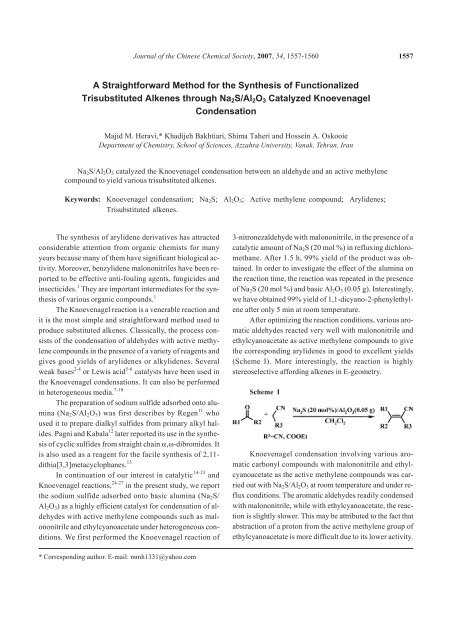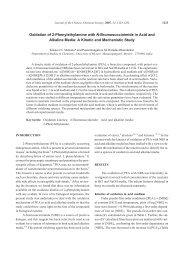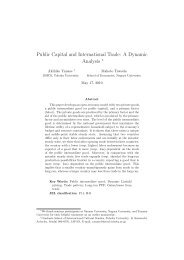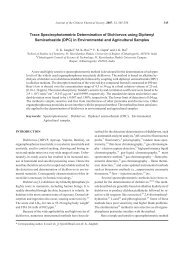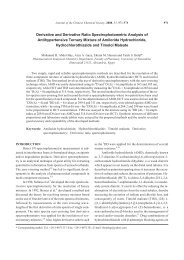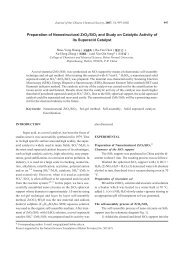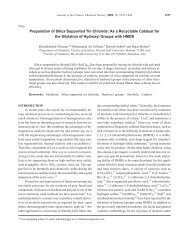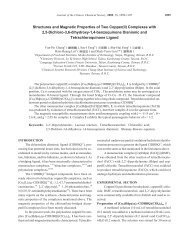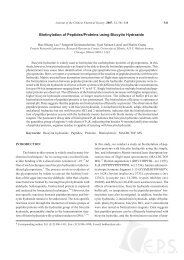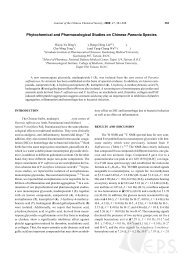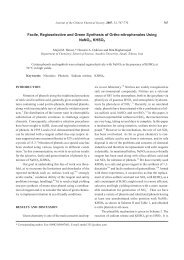A Straightforward Method for the Synthesis of Functionalized ...
A Straightforward Method for the Synthesis of Functionalized ...
A Straightforward Method for the Synthesis of Functionalized ...
Create successful ePaper yourself
Turn your PDF publications into a flip-book with our unique Google optimized e-Paper software.
A <strong>Straight<strong>for</strong>ward</strong> <strong>Method</strong> <strong>for</strong> <strong>the</strong> Syn<strong>the</strong>sis <strong>of</strong> <strong>Functionalized</strong><br />
Trisubstituted Alkenes through Na2S/Al2O3 Catalyzed Knoevenagel<br />
Condensation<br />
Majid M. Heravi,* Khadijeh Bakhtiari, Shima Taheri and Hossein A. Oskooie<br />
Department <strong>of</strong> Chemistry, School <strong>of</strong> Sciences, Azzahra University, Vanak, Tehran, Iran<br />
Na2S/Al2O3 catalyzed <strong>the</strong> Knoevenagel condensation between an aldehyde and an active methylene<br />
compound to yield various trisubstituted alkenes.<br />
Keywords: Knoevenagel condensation; Na2S; Al2O3; Active methylene compound; Arylidenes;<br />
Trisubstituted alkenes.<br />
The syn<strong>the</strong>sis <strong>of</strong> arylidene derivatives has attracted<br />
considerable attention from organic chemists <strong>for</strong> many<br />
years because many <strong>of</strong> <strong>the</strong>m have significant biological activity.<br />
Moreover, benzylidene malononitriles have been reported<br />
to be effective anti-fouling agents, fungicides and<br />
insecticides. 1 They are important intermediates <strong>for</strong> <strong>the</strong> syn<strong>the</strong>sis<br />
<strong>of</strong> various organic compounds. 1<br />
The Knoevenagel reaction is a venerable reaction and<br />
it is <strong>the</strong> most simple and straight<strong>for</strong>ward method used to<br />
produce substituted alkenes. Classically, <strong>the</strong> process consists<br />
<strong>of</strong> <strong>the</strong> condensation <strong>of</strong> aldehydes with active methylene<br />
compounds in <strong>the</strong> presence <strong>of</strong> a variety <strong>of</strong> reagents and<br />
gives good yields <strong>of</strong> arylidenes or alkylidenes. Several<br />
weak bases 2-4 or Lewis acid 5-6 catalysts have been used in<br />
<strong>the</strong> Knoevenagel condensations. It can also be per<strong>for</strong>med<br />
in heterogeneous media. 7-10<br />
The preparation <strong>of</strong> sodium sulfide adsorbed onto alumina<br />
(Na2S/Al2O3) was first describes by Regen 11 who<br />
used it to prepare dialkyl sulfides from primary alkyl halides.<br />
Pagni and Kabala 12 later reported its use in <strong>the</strong> syn<strong>the</strong>sis<br />
<strong>of</strong> cyclic sulfides from straight chain ,-dibromides. It<br />
is also used as a reagent <strong>for</strong> <strong>the</strong> facile syn<strong>the</strong>sis <strong>of</strong> 2,11dithia[3,3]metacyclophanes.<br />
13<br />
In continuation <strong>of</strong> our interest in catalytic 14-23 and<br />
Knoevenagel reactions, 24-27 in <strong>the</strong> present study, we report<br />
<strong>the</strong> sodium sulfide adsorbed onto basic alumina (Na2S/<br />
Al2O3) as a highly efficient catalyst <strong>for</strong> condensation <strong>of</strong> aldehydes<br />
with active methylene compounds such as malononitrile<br />
and ethylcyanoacetate under heterogeneous conditions.<br />
We first per<strong>for</strong>med <strong>the</strong> Knoevenagel reaction <strong>of</strong><br />
* Corresponding author. E-mail: mmh1331@yahoo.com<br />
Journal <strong>of</strong> <strong>the</strong> Chinese Chemical Society, 2007, 54, 1557-1560 1557<br />
3-nitronezaldehyde with malononitrile, in <strong>the</strong> presence <strong>of</strong> a<br />
catalytic amount <strong>of</strong> Na2S (20 mol %) in refluxing dichloromethane.<br />
After 1.5 h, 99% yield <strong>of</strong> <strong>the</strong> product was obtained.<br />
In order to investigate <strong>the</strong> effect <strong>of</strong> <strong>the</strong> alumina on<br />
<strong>the</strong> reaction time, <strong>the</strong> reaction was repeated in <strong>the</strong> presence<br />
<strong>of</strong> Na2S (20 mol %) and basic Al2O3 (0.05 g). Interestingly,<br />
we have obtained 99% yield <strong>of</strong> 1,1-dicyano-2-phenylethylene<br />
after only 5 min at room temperature.<br />
After optimizing <strong>the</strong> reaction conditions, various aromatic<br />
aldehydes reacted very well with malononitrile and<br />
ethylcyanoacetate as active methylene compounds to give<br />
<strong>the</strong> corresponding arylidenes in good to excellent yields<br />
(Scheme I). More interestingly, <strong>the</strong> reaction is highly<br />
stereoselective af<strong>for</strong>ding alkenes in E-geometry.<br />
Scheme I<br />
Knoevenagel condensation involving various aromatic<br />
carbonyl compounds with malononitrile and ethylcyanoacetate<br />
as <strong>the</strong> active methylene compounds was carried<br />
out with Na2S/Al2O3 at room temperature and under reflux<br />
conditions. The aromatic aldehydes readily condensed<br />
with malononitrile, while with ethylcyanoacetate, <strong>the</strong> reaction<br />
is slightly slower. This may be attributed to <strong>the</strong> fact that<br />
abstraction <strong>of</strong> a proton from <strong>the</strong> active methylene group <strong>of</strong><br />
ethylcyanoacetate is more difficult due to its lower activity.
1558 J. Chin. Chem. Soc., Vol. 54, No. 6, 2007 Heravi et al.<br />
Table 1. Knoevenagel condensation catalyzed by Na 2S/Al 2O 3<br />
Entry R 1<br />
It can be seen from Table 1 that all reactions proceed selectively<br />
to <strong>the</strong> dehydrated products without any side reaction.<br />
No self-condensation, Cannizaro products or hydrated products<br />
<strong>of</strong> Knoevenagel adducts were obtained.<br />
As shown in Table 1, aromatic aldehydes containing<br />
both electron donating or withdrawing groups gave <strong>the</strong> desired<br />
products in good to excellent yields in <strong>the</strong> reaction<br />
time ranging from 5 to 65 minutes. Deactivated aldehydes<br />
such as nitrobenzaldehyde isomers and 4-chlorobenzaldehyde<br />
required shorter reaction times due to <strong>the</strong> electron<br />
withdrawing groups (Table 1, entries 2-5, 13-16). Moreover,<br />
<strong>the</strong> steric hindrance seems to have significant effects<br />
on <strong>the</strong> reaction times and yields (Table 1, entries 7-8, 18-<br />
19). We also investigated Knoevenagel condensation <strong>of</strong> ketones<br />
with malononitrile and ethylcyanoacetate. No reactions<br />
occurred under <strong>the</strong> conditions in which aldehydes<br />
gave almost quantitative conversions.<br />
The use <strong>of</strong> Na2S/Al2O3 as catalyst in this reaction allowed<br />
us to per<strong>for</strong>m <strong>the</strong> condensation under mild conditions.<br />
In this case, yields were excellent. The salient features<br />
<strong>of</strong> this reaction are <strong>the</strong> following: a) use <strong>of</strong> inexpensive<br />
and readily available catalyst b) and simplicity <strong>of</strong> per<strong>for</strong>mance<br />
and work-up. In order to show <strong>the</strong> merit <strong>of</strong> <strong>the</strong><br />
R 2<br />
R 3<br />
Time<br />
(min)<br />
Condition Yield (%) a<br />
m.p. (C)<br />
Found Reported<br />
1 C6H5-H CN 20 Reflux 90 83-84 83 28<br />
2 4-Cl-C6H4-HCN30 Reflux 90 166-167 164 31<br />
3<br />
4<br />
2-NO2-C6H4- 3-NO2-C6H4- H<br />
H<br />
CN<br />
CN<br />
10<br />
5<br />
room temperature<br />
room temperature<br />
98<br />
99<br />
141-142<br />
101-103<br />
-<br />
104-105 29<br />
5 4-NO2-C6H4- H CN 5 room temperature 97 161-162 159-160 28<br />
6 4-CH3-C6H4- H CN 55 Reflux 96 137-138 135 32<br />
7 2-CH3O-C6H4- H CN 45 Reflux 97 80 78 35<br />
8 4-CH3O-C6H4- H CN 10 Reflux 94 113-114 115 28<br />
9 C6H5-HC=CH- H CN 5 Reflux 98 122-123 128 32<br />
10 C6H5- C6H5CN 24 hours Reflux No reaction - -<br />
11<br />
12<br />
C6H5- C6H5- CH3 H<br />
CN<br />
COOEt<br />
24 hours<br />
25<br />
Reflux<br />
Reflux<br />
No reaction<br />
90<br />
-<br />
50-51<br />
-<br />
52 28<br />
13 4-Cl-C6H4- H COOEt 45 Reflux 90 87-89 87 34<br />
14 2-NO2-C6H4- H COOEt 7 room temperature 96 102 96 35<br />
15 3-NO2-C6H4- H COOEt 5 room temperature 95 130 128-132 33<br />
16 4-NO2-C6H4- H COOEt 7 room temperature 95 169 170 34<br />
17 4-CH3-C6H4- H COOEt 65 Reflux 94 93-94 92 28<br />
18 2-CH3O-C6H4- H COOEt 60 Reflux 90 70 69 34<br />
19 4-CH3O-C6H4- H COOEt 30 Reflux 86 85 80-84 28<br />
20 HC=CH-C6H5 H COOEt 5 Reflux 96 115 116 30<br />
21 C6H5- C6H5COOEt 24 hours Reflux No reaction - -<br />
22 C6H5- CH3COOEt 24 hours Reflux No reaction - -<br />
a<br />
Yields refer to <strong>the</strong> isolated pure products.<br />
present work in comparison with some reported procedures,<br />
we compared <strong>the</strong> results <strong>of</strong> <strong>the</strong> syn<strong>the</strong>sis <strong>of</strong> olefinic<br />
compounds in <strong>the</strong> presence <strong>of</strong> HZSM-5, 24 Proline, 36 RE-<br />
NaY zeolite 37 and Na2S/Al2O3 with respect to <strong>the</strong> reaction<br />
times and yield <strong>of</strong> products (Table 2). The results show that<br />
Na2S/Al2O3 promotes <strong>the</strong> reaction more effectively than<br />
HZSM-5. Reaction in <strong>the</strong> presence <strong>of</strong> o<strong>the</strong>r catalysts in Table<br />
2 required longer reaction times.<br />
In summary, we have demonstrated <strong>the</strong> Na2S/Al2O3<br />
catalyzed condensation between various aldehydes and active<br />
methylene compounds in a heterogeneous system. This<br />
method <strong>of</strong>fers some advantages in terms <strong>of</strong> simplicity <strong>of</strong><br />
per<strong>for</strong>mance, easy work-up, use <strong>of</strong> inexpensive, available<br />
and easy to handle catalysts and high yields <strong>of</strong> products and<br />
Table 2. Comparison <strong>of</strong> <strong>the</strong> syn<strong>the</strong>sis <strong>of</strong> trisubstituted alkenes<br />
using different catalysts<br />
Entry Catalyst Time Yield (%) Ref.<br />
1 HZSM-5 5-12 (h) 60-80 24<br />
2 Proline Over night 66-100 36<br />
3 RE–NaY Zeolite 8-18 (h) 78-100 37<br />
4 Na2S/Al2O3 5-65 (min) 86-99 This work
Syn<strong>the</strong>sis <strong>of</strong> <strong>Functionalized</strong> Trisubstituted Alkenes J. Chin. Chem. Soc., Vol. 54, No. 6, 2007 1559<br />
relatively short reaction times.<br />
EXPERIMENTAL<br />
Melting points were measured by using <strong>the</strong> capillary<br />
tube method with an electro <strong>the</strong>rmal 9100 apparatus. 1 H<br />
NMR spectra were recorded on a Brucker DRX-90 AVANCE<br />
by using TMS as an internal standard (CDCl3 solution). IR<br />
spectra were recorded as KBr disc on <strong>the</strong> FT-IR Brucker<br />
Tensor 27. All products were known compounds and identified<br />
by comparison <strong>of</strong> <strong>the</strong>ir spectral and physical data on<br />
<strong>the</strong> basis <strong>of</strong> literature descriptions. 28-35<br />
Reaction <strong>of</strong> aldehydes with active methylene compounds:<br />
General procedure<br />
Na2S.9H2O (20 mol %) and basic alumina (0.05 g)<br />
were mixed thoroughly in a mortar. To this mixture CH2Cl2<br />
(3 mL), aldehyde (1 mmol) and active methylene compound<br />
(1 mmol) were added. The mixture was stirred at<br />
room temperature or under reflux <strong>for</strong> <strong>the</strong> indicated time<br />
(Table 1). After completion <strong>of</strong> <strong>the</strong> reaction, as indicated by<br />
TLC, <strong>the</strong> mixture was filtered <strong>of</strong>f. Upon <strong>the</strong> evaporation <strong>of</strong><br />
solvent, <strong>the</strong> crude product was recrystallized from ethanol<br />
and identified by comparison <strong>of</strong> spectral and physical data<br />
with those described in <strong>the</strong> literature.<br />
ACKNOWLEDGMENTS<br />
MMH is thankful to <strong>the</strong> Azzahra University Research<br />
Council <strong>for</strong> partial financial support.<br />
Received March 5, 2007.<br />
REFERENCES<br />
1. Bigi, F.; Con<strong>for</strong>ti, M. L.; Maggi, R.; Piccinno, A.; Sartori, G.<br />
Green Chem. 2002, 2, 101.<br />
2. Jones, G. Organic Reactions; Wiley: New York, 1967; Vol.<br />
XV; p 204.<br />
3. Heravi, M. M.; Derikvand, F.; Haghighi, M.; Bakhtiari, Kh.<br />
Lett. Org. Chem. 2006, 3, 297.<br />
4. March, J. Advanced Organic Chemistry: Reactions, Mechanisms,<br />
and Structure;4 th ed; Wiley: New York, 1992.<br />
5. Rao, P. S.; Ratnam, R. V. Tetrahedron Lett. 1991, 32, 5821.<br />
6. Lehnert, W. Syn<strong>the</strong>sis 1974, 667.<br />
7. Bram, G.; Loupy, A.; Villemin, D. In Solid Supports and<br />
Catalyst in Organic Syn<strong>the</strong>sis; Smith, K., Ed.; Ellis Horwood<br />
and Prentice Hall: Chichester, 1992; Ch. 12.<br />
8. Moison, H.; Texier-Boullet, F.; Foucaud, A. Tetrahedron<br />
Lett. 1987, 43, 537.<br />
9. Siebenhaar, B.; Casagrande, B.; Studer, M.; Blaser, H-U.<br />
Canadian J. Chem. 2001, 79, 566.<br />
10. Angeletti, E.; Canepa, C.; Martinetti, G.; Venturello, P. Tetrahedron<br />
Lett. 1988, 29, 2261.<br />
11. Czech, B.; Zuici, S.; Regen, S. L. Syn<strong>the</strong>sis 1980, 113.<br />
12. Tan, L. C.; Pagni, R. M.; Kabalka, G. W.; Hillmyer, M.;<br />
Woolsey, J. Tetrahedron Lett. 1992, 33, 7709.<br />
13. Bodwell, G. J.; Houghton, T. J.; Koury, H. E.; Yarlagadda, B.<br />
Synlett 1995, 751.<br />
14. Heravi, M. M.; Behbahani, F. K.; Oskooie, H. A.; Hekmatshoar,<br />
R. Tetrahedron Lett. 2005, 46, 2775.<br />
15. Heravi, M. M.; Hekmatshoar, R.; Pedram, L. J. Mol. Catal.<br />
A: Chem. 2005, 231, 89.<br />
16. Heravi, M. M.; Tajbakhsh, M.; Mohajerani, B.; Ghassemzadeh,<br />
M. Z. Natur<strong>for</strong>sch. 1999, 54, 541.<br />
17. Heravi, M. M.; Bakhtiari, K.; Bamoharram, F. F. Catal.<br />
Commun. 2006, 7, 373.<br />
18. Bamoharram, F. F.; Heravi, M. M.; Roshani, M.; Gharib, A.;<br />
Jahangir M. J. Mol. Catal. A. Chem. 2006, 252, 90.<br />
19. Bamoharram, F. F.; Heravi, M. M.; Roshani, M.; Tavakoli,<br />
N. J. Mol. Catal. A. Chem. 2006, 252, 219.<br />
20. Heravi, M. M.; Motamedi, R.; Seifi, N.; Bamoharram, F. F.<br />
J. Mol. Catal. A. Chem. 2006, 249,1.<br />
21. Bamoharram, F. F.; Heravi, M. M.; Roshani, M.; Jahangir,<br />
M.; Gharib, A. Appl. Catal. A. General. 2006, 302, 42.<br />
22. Heravi, M. M.; Behbahani, F. K.; Hekmat Shoar, R.;<br />
Oskooie, H. Catal. Commun. 2006, 7, 136.<br />
23. Heravi, M. M.; Behbahani, F. K.; Hekmat Shoar, R.;<br />
Oskooie, H. A. J.Mol.Catal.A.Chem.2006, 244,8.<br />
24. Heravi, M. M.; Tajbakhsh, M.; Mohajerani, B.; Ghasemzadeh,<br />
M. Indian J. Chem., B. 1999, 38, 857.<br />
25. Shokravi, A.; Sharghi, H.; Valizadeh, H.; Heravi, M. M.<br />
Phosphorus, Sulfur Silicon Relat. Elem. 2002, 177, 2555.<br />
26. Heravi, M. M.; Hekmatshoar, R.; Emamgholizadeh, M.<br />
Phosphorus, Sulfur Silicon Relat. Elem. 2004, 179, 1893.<br />
27. Oskooie, H, A.; Roomizadeh, E.; Heravi, M, M. J. Chem.<br />
Res. 2006, 246.<br />
28. Cabello, J. A.; Campelo, J. M.; Garica, A.; Luna, D.; Marinas,<br />
J. M. J. Org. Chem. 1984, 49, 5195.<br />
29. Cao, Y.-Q.; Dai, Z.; Zhang, R.; Chen, B.-H. Synth. Commun.<br />
2004, 34, 2965.<br />
30. Narsaiah, A. V.; Basak, A. K.; Visali, B.; Nagaiah, K. Synth.<br />
Commun. 2004, 34, 2893.
1560 J. Chin. Chem. Soc., Vol. 54, No. 6, 2007 Heravi et al.<br />
31. The Aldrich Library <strong>of</strong> Infrared Spectra; 3 rd ed.; Aldrich<br />
Chemical Co., Eds.; 1981.<br />
32. Beilstein, Handbuch der Organisation Chemie, Springer-<br />
Verlag: Berlin, Band 9, p 913.<br />
33. Mitra, A. K.; De, A.; Karchaudhuri, N. Synth. Commun.<br />
1999, 29, 2731.<br />
34. Choudrary, B. M.; Lakshmi Kantam, M.; Kavita, B.; Reddy,<br />
Ch. V.; Figueras, F. Tetrahedron 2000, 56, 9357.<br />
35. Beilstein, Handbuch der Organischen Chemie, Springer-<br />
Verlag: Berlin, Band 9, p 4383.<br />
36. Cardillo, G.; Fabbroni, S.; Gentilucci, L.; Gianotti, M. E.;<br />
Tolomelli, A. Synth. Commun. 2003, 33, 1587.<br />
37. Reddy,T.I.;Varma,R.S. Tetrahedron Lett. 1997, 38, 1721.


